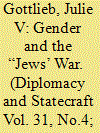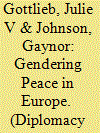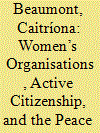|
|
|
Sort Order |
|
|
|
Items / Page
|
|
|
|
|
|
|
| Srl | Item |
| 1 |
ID:
176162


|
|
|
|
|
| Summary/Abstract |
As the twentieth century dawned, fledgling transnational networks of peace activists, including the International Peace Bureau and the Interparliamentary Union, grew in prominence, not least in Europe. Impetus came from the United States, notably via the Lake Mohonk conferences and emergent organisations like the Carnegie Endowment for International Peace and the World Peace Foundation. Each group purported to speak on behalf of an inclusive and ‘international’ public opinion, yet men dominated them all. This analysis considers the challenge and sustainment to this male dominance in the period from 1880 to 1920, exploring the intersection between existing peace groups and an emergent feminist pacifism. Peace activists of all stripes believed that public opinion’s influence was growing, and most positioned themselves as representatives of an enlightened public sentiment; but the composition of this public sphere, and the space afforded within it for women, remained a site of contestation.
|
|
|
|
|
|
|
|
|
|
|
|
|
|
|
|
| 2 |
ID:
176164


|
|
|
|
|
| Summary/Abstract |
The expansion of citizenship rights for women in the largely democratic Successor States followed the collapse of the Habsburg Empire and the end of the First World War in 1918. Many women’s rights activists hoped that the participation of women in the political sphere would now lead to a more peaceful future. However, during the post-war period, revolutionary movements and persistent violent conflicts dominated Central and Eastern Europe. Some socialist women supported – and participated in – the region’s widespread violence. This analysis explores the tension between pacifism and militancy within the First Austrian Republic through an investigation of how this friction shaped socialist and feminist women’s political activism and writings. The question of political violence shaped gendered identities, distinguishing between the configurations of the “peaceful woman” and the “female revolutionary”.
|
|
|
|
|
|
|
|
|
|
|
|
|
|
|
|
| 3 |
ID:
176168


|
|
|
|
|
| Summary/Abstract |
The study of the gender complexion of pacifist movements has greatly expanded in recent decades, a product of the convergence of the new international history and study of transnationalism with the ever firmer rooting of women’s and gender history. Yet the study of pacifism in wartime has received less attention, and that of unlikelier pacifists emerging from the far Right even less. The British Union of Fascists and National Socialists [BU] launched its ‘Peace Campaign’ in 1938, and women fascists played leading roles on both practical and symbolic levels. It culminated in the launch of their own Women’s Peace Campaign in 1940, relying heavily on tropes of women’s innate pacifism and, more narrowly, domestic concerns in the home and on the home front. The BU’s policy shift from para-militarism to a militant non-interventionism and a racially motivated isolationism was more accurately an anti-war and stop-the-war campaign. Even before 1939, they dubbed the world war the ‘Jews’ War’, and women contributed in equal measure to the xenophobic and racialist charge of the BU’s campaign. However, situating anti-war fascist women amongst other women’s groups who organised to oppose the Second World War, in particularly in the Peace Pledge Union – which had launched a Women’s Peace Campaign in December 1939 – exposes the variegated nature of British women’s activism and attitudes from the high water mark of appeasement to the end of the Phoney War.
|
|
|
|
|
|
|
|
|
|
|
|
|
|
|
|
| 4 |
ID:
176161


|
|
|
|
|
| Summary/Abstract |
This introduction tracks how international and diplomatic history have, gradually, been gendered, as well as tracing the evolving interest in the role of women in peace movements. Most articles in this special issues developed from contributions to the ‘Gendering Peace in Europe’ conference held at the University of Sheffield in January, 2017, and here we consider the ways in which the category of gender can be more firmly embedded into research in the field of diplomacy and statecraft.
|
|
|
|
|
|
|
|
|
|
|
|
|
|
|
|
| 5 |
ID:
176163


|
|
|
|
|
| Summary/Abstract |
Some pacifist women active during and after the First World War consciously chose a rhetoric of love and shared humanity. Used to counteract the discourse of hate that dominated belligerent nations at this time, it was central to the vision of a feminist peace developed by women’s groups working to oppose the war, such as the Women’s International League for Peace and Freedom [WILPF]. Using the insights gained by scholarship on the history of emotions, this analysis explores the gendered ways in which members of the WILPF performed and evoked emotions of friendship, love, and sisterhood to create, consolidate and reflect emotional communities during and in the aftermath of the First World War within and beyond their own national contexts. In the majority of belligerent nations, the majority of the women’s organisations engaged in patriotic war service and rejected WILPF members’ anti-war activism as sentimental and naive. This analysis argues that they deployed articulations of love at all stages of the war and its aftermath as both a moral imperative and a powerful, gendered strategy of resistance that was central to their claim to greater political influence at home and abroad.
|
|
|
|
|
|
|
|
|
|
|
|
|
|
|
|
| 6 |
ID:
176165


|
|
|
|
|
| Summary/Abstract |
Political violence was a fact of Irish life in the early twentieth century, exacerbated by the sacrificial and martial cultures that grew out of nationalist and unionist politics. The Irish women’s movement developed in this context, adjusting to the demands made on activists by these particular circumstances, and playing a vital role in all the major political movements of the era. Buoyed by the achievement of partial women’s enfranchisement in 1918, Irish women prepared to play an enhanced role in the formal life of the country. However, they quickly found that the rights they believed they had won were less than secure, and they turned to new and existing strategies in their efforts to adjust to the reality of independent Ireland.
|
|
|
|
|
|
|
|
|
|
|
|
|
|
|
|
| 7 |
ID:
176170


|
|
|
|
|
| Summary/Abstract |
This analysis explores the shifting definitions of what constituted a diplomat in post-Second World War Britain. Post-war women’s liberation generated unique dilemmas for Foreign Office recruiters: whilst reluctant to employ women on equal terms with men, they nonetheless fell under pressure to demonstrate that Britain’s self-styled international reputation as a vanquisher of Nazi tyranny and oppression applied to women’s employment. Women were admitted to the Diplomatic Service in 1946 on the basis that arguments in favour of women diplomats complemented and even enhanced Foreign Office attempts to model itself as a bastion of equal opportunity, fairness, and, later, ‘meritocracy’. This analysis explores internal Foreign Office debates about the employment of women diplomats after the Second World War, but it also makes a related argument about the value of ‘organisation history’ and what a study of Foreign Office culture can reveal about the society in which is operated.
|
|
|
|
|
|
|
|
|
|
|
|
|
|
|
|
| 8 |
ID:
176169


|
|
|
|
|
| Summary/Abstract |
The history of modern British foreign policy largely devolves from an exclusively male perspective. In many respects, this was natural and appropriate because, until the 1940s, only men held senior positions in the Diplomatic Service. During the early twentieth century, attempts to change the “Foreign Office mind” to promote a greater acceptance of the role of women in the conduct and formulation of British diplomacy remained largely resisted. However, when examining the careers of the other group of women who worked at the Foreign Office, the clerical staff, the vast ranks of filing clerks, and shorthand typists, a very different view of this bastion of male conservatism emerges. With prosopography and on-line genealogy resources, this analysis traces a large cross-section of these women and analyses their life patterns and working experiences. It reveals that many of these women enjoyed quite a flexible working experience, with plenty of opportunities for career advancement, with some even transferring from the clerical classes to the Consular Service. This exegesis represents the first attempt to use prosoprographic techniques in the study of British foreign policy and suggests other ways to expand the present study and other similar projects undertaken to examine other government departments concerned with foreign affairs.
|
|
|
|
|
|
|
|
|
|
|
|
|
|
|
|
| 9 |
ID:
176166


|
|
|
|
|
| Summary/Abstract |
The history of women’s engagement in the interwar peace movement has focused primarily on feminist pacifists, individuals who participated in both the women’s suffrage movement and the peace movement. Much less attention has been given to the peace activism of voluntary women’s groups that did not self-identify as feminist but which were equally committed to preserving peace. This analysis explores the contribution of three women’s organisations – the National Council of Women, the Women’s Institutes, and the Young Women’s Christian Association – to the interwar peace movement. Their involvement not only reveals the extent of their anti-war activism but calls into question long-held assumptions about what motivated women to engage in the campaign for peace. This re-evaluation provides new insights into the varied reasons why women wanted peace and challenges the belief that anti-war activism weakened the women’s movement during the interwar years.
|
|
|
|
|
|
|
|
|
|
|
|
|
|
|
|
| 10 |
ID:
176167


|
|
|
|
|
| Summary/Abstract |
This analysis focuses on the ways in which the interwar Yugoslav women’s movement contributed to national and international political processes of that time, and it divides into two parts. The first deals with the national efforts of the Yugoslav women’s umbrella alliance and its endorsement of the concepts of Yugoslavia and a Yugoslav nation. The second analyses the international activities of Yugoslav women’s organisations on a global and regional level. It investigates the ways that women’s co-operation was used to promote peaceful solutions to regional and international conflicts. However, the national and international women’s movement was a social product of its time. Although promoting pacifism and transnational concepts, in many ways it also faced, mirrored, and sometimes perpetuated contemporary social and national conflicts and prejudices.
|
|
|
|
|
|
|
|
|
|
|
|
|
|
|
|
|
|
|
|
|